Qian Qiao
RAP: Real-time Audio-driven Portrait Animation with Video Diffusion Transformer
Aug 07, 2025Abstract:Audio-driven portrait animation aims to synthesize realistic and natural talking head videos from an input audio signal and a single reference image. While existing methods achieve high-quality results by leveraging high-dimensional intermediate representations and explicitly modeling motion dynamics, their computational complexity renders them unsuitable for real-time deployment. Real-time inference imposes stringent latency and memory constraints, often necessitating the use of highly compressed latent representations. However, operating in such compact spaces hinders the preservation of fine-grained spatiotemporal details, thereby complicating audio-visual synchronization RAP (Real-time Audio-driven Portrait animation), a unified framework for generating high-quality talking portraits under real-time constraints. Specifically, RAP introduces a hybrid attention mechanism for fine-grained audio control, and a static-dynamic training-inference paradigm that avoids explicit motion supervision. Through these techniques, RAP achieves precise audio-driven control, mitigates long-term temporal drift, and maintains high visual fidelity. Extensive experiments demonstrate that RAP achieves state-of-the-art performance while operating under real-time constraints.
Marrying Autoregressive Transformer and Diffusion with Multi-Reference Autoregression
Jun 11, 2025Abstract:We introduce TransDiff, the first image generation model that marries Autoregressive (AR) Transformer with diffusion models. In this joint modeling framework, TransDiff encodes labels and images into high-level semantic features and employs a diffusion model to estimate the distribution of image samples. On the ImageNet 256x256 benchmark, TransDiff significantly outperforms other image generation models based on standalone AR Transformer or diffusion models. Specifically, TransDiff achieves a Fr\'echet Inception Distance (FID) of 1.61 and an Inception Score (IS) of 293.4, and further provides x2 faster inference latency compared to state-of-the-art methods based on AR Transformer and x112 faster inference compared to diffusion-only models. Furthermore, building on the TransDiff model, we introduce a novel image generation paradigm called Multi-Reference Autoregression (MRAR), which performs autoregressive generation by predicting the next image. MRAR enables the model to reference multiple previously generated images, thereby facilitating the learning of more diverse representations and improving the quality of generated images in subsequent iterations. By applying MRAR, the performance of TransDiff is improved, with the FID reduced from 1.61 to 1.42. We expect TransDiff to open up a new frontier in the field of image generation.
TextFlux: An OCR-Free DiT Model for High-Fidelity Multilingual Scene Text Synthesis
May 23, 2025

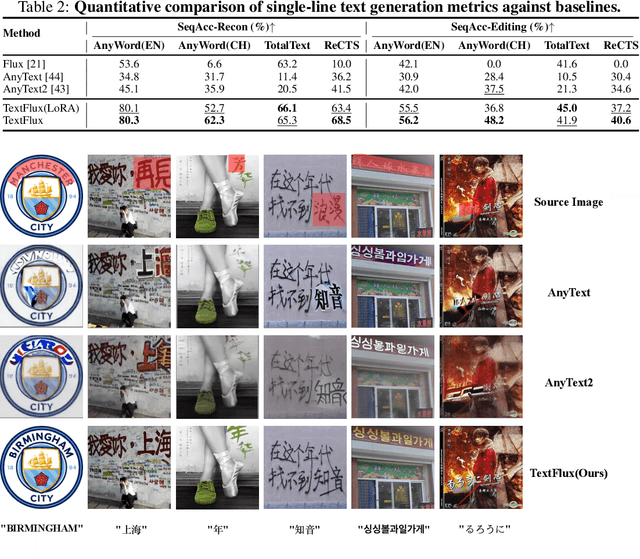
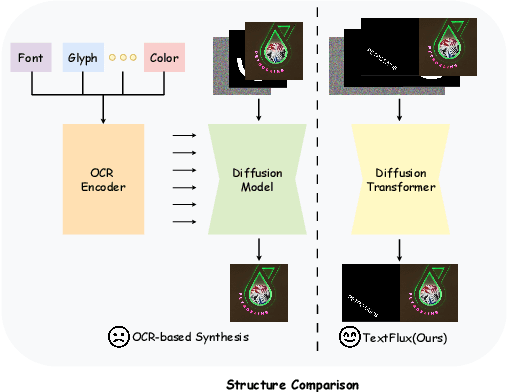
Abstract:Diffusion-based scene text synthesis has progressed rapidly, yet existing methods commonly rely on additional visual conditioning modules and require large-scale annotated data to support multilingual generation. In this work, we revisit the necessity of complex auxiliary modules and further explore an approach that simultaneously ensures glyph accuracy and achieves high-fidelity scene integration, by leveraging diffusion models' inherent capabilities for contextual reasoning. To this end, we introduce TextFlux, a DiT-based framework that enables multilingual scene text synthesis. The advantages of TextFlux can be summarized as follows: (1) OCR-free model architecture. TextFlux eliminates the need for OCR encoders (additional visual conditioning modules) that are specifically used to extract visual text-related features. (2) Strong multilingual scalability. TextFlux is effective in low-resource multilingual settings, and achieves strong performance in newly added languages with fewer than 1,000 samples. (3) Streamlined training setup. TextFlux is trained with only 1% of the training data required by competing methods. (4) Controllable multi-line text generation. TextFlux offers flexible multi-line synthesis with precise line-level control, outperforming methods restricted to single-line or rigid layouts. Extensive experiments and visualizations demonstrate that TextFlux outperforms previous methods in both qualitative and quantitative evaluations.
Large Language Model Compression with Global Rank and Sparsity Optimization
May 02, 2025Abstract:Low-rank and sparse composite approximation is a natural idea to compress Large Language Models (LLMs). However, such an idea faces two primary challenges that adversely affect the performance of existing methods. The first challenge relates to the interaction and cooperation between low-rank and sparse matrices, while the second involves determining weight allocation across different layers, as redundancy varies considerably among them. To address these challenges, we propose a novel two-stage LLM compression method with the capability of global rank and sparsity optimization. It is noteworthy that the overall optimization space is vast, making comprehensive optimization computationally prohibitive. Therefore, to reduce the optimization space, our first stage utilizes robust principal component analysis to decompose the weight matrices of LLMs into low-rank and sparse components, which span the low dimensional and sparse spaces containing the resultant low-rank and sparse matrices, respectively. In the second stage, we propose a probabilistic global optimization technique to jointly identify the low-rank and sparse structures within the above two spaces. The appealing feature of our approach is its ability to automatically detect the redundancy across different layers and to manage the interaction between the sparse and low-rank components. Extensive experimental results indicate that our method significantly surpasses state-of-the-art techniques for sparsification and composite approximation.
Efficient Fine-Tuning of Quantized Models via Adaptive Rank and Bitwidth
May 02, 2025Abstract:QLoRA effectively combines low-bit quantization and LoRA to achieve memory-friendly fine-tuning for large language models (LLM). Recently, methods based on SVD for continuous update iterations to initialize LoRA matrices to accommodate quantization errors have generally failed to consistently improve performance. Dynamic mixed precision is a natural idea for continuously improving the fine-tuning performance of quantized models, but previous methods often optimize low-rank subspaces or quantization components separately, without considering their synergy. To address this, we propose \textbf{QR-Adaptor}, a unified, gradient-free strategy that uses partial calibration data to jointly search the quantization components and the rank of low-rank spaces for each layer, thereby continuously improving model performance. QR-Adaptor does not minimize quantization error but treats precision and rank allocation as a discrete optimization problem guided by actual downstream performance and memory usage. Compared to state-of-the-art (SOTA) quantized LoRA fine-tuning methods, our approach achieves a 4.89\% accuracy improvement on GSM8K, and in some cases even outperforms the 16-bit fine-tuned model while maintaining the memory footprint of the 4-bit setting.
QPruner: Probabilistic Decision Quantization for Structured Pruning in Large Language Models
Dec 16, 2024Abstract:The rise of large language models (LLMs) has significantly advanced various natural language processing (NLP) tasks. However, the resource demands of these models pose substantial challenges. Structured pruning is an effective approach to reducing model size, but it often results in significant accuracy degradation, necessitating parameter updates to adapt. Unfortunately, such fine-tuning requires substantial memory, which limits its applicability. To address these challenges, we introduce quantization into the structured pruning framework to reduce memory consumption during both fine-tuning and inference. However, the combined errors from pruning and quantization increase the difficulty of fine-tuning, requiring a more refined quantization scheme. To this end, we propose QPruner, a novel framework that employs structured pruning to reduce model size, followed by a layer-wise mixed-precision quantization scheme. Quantization precisions are assigned to each layer based on their importance to the target task, and Bayesian optimization is employed to refine precision allocation strategies, ensuring a balance between model accuracy and memory efficiency. Extensive experiments on benchmark datasets demonstrate that QPruner significantly outperforms existing methods in memory savings while maintaining or improving model performance.
A Simple Task-aware Contrastive Local Descriptor Selection Strategy for Few-shot Learning between inter class and intra class
Aug 12, 2024Abstract:Few-shot image classification aims to classify novel classes with few labeled samples. Recent research indicates that deep local descriptors have better representational capabilities. These studies recognize the impact of background noise on classification performance. They typically filter query descriptors using all local descriptors in the support classes or engage in bidirectional selection between local descriptors in support and query sets. However, they ignore the fact that background features may be useful for the classification performance of specific tasks. This paper proposes a novel task-aware contrastive local descriptor selection network (TCDSNet). First, we calculate the contrastive discriminative score for each local descriptor in the support class, and select discriminative local descriptors to form a support descriptor subset. Finally, we leverage support descriptor subsets to adaptively select discriminative query descriptors for specific tasks. Extensive experiments demonstrate that our method outperforms state-of-the-art methods on both general and fine-grained datasets.
DNTextSpotter: Arbitrary-Shaped Scene Text Spotting via Improved Denoising Training
Aug 01, 2024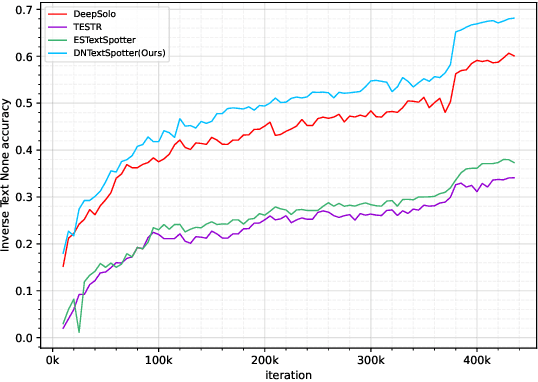
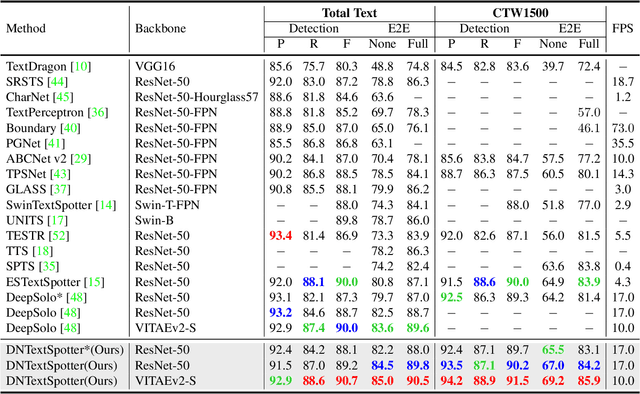

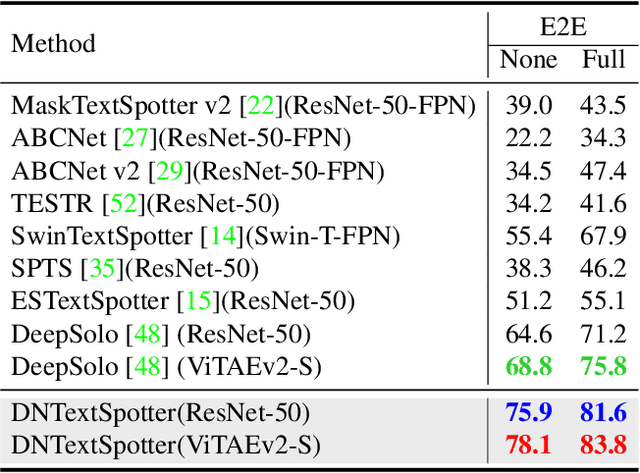
Abstract:More and more end-to-end text spotting methods based on Transformer architecture have demonstrated superior performance. These methods utilize a bipartite graph matching algorithm to perform one-to-one optimal matching between predicted objects and actual objects. However, the instability of bipartite graph matching can lead to inconsistent optimization targets, thereby affecting the training performance of the model. Existing literature applies denoising training to solve the problem of bipartite graph matching instability in object detection tasks. Unfortunately, this denoising training method cannot be directly applied to text spotting tasks, as these tasks need to perform irregular shape detection tasks and more complex text recognition tasks than classification. To address this issue, we propose a novel denoising training method (DNTextSpotter) for arbitrary-shaped text spotting. Specifically, we decompose the queries of the denoising part into noised positional queries and noised content queries. We use the four Bezier control points of the Bezier center curve to generate the noised positional queries. For the noised content queries, considering that the output of the text in a fixed positional order is not conducive to aligning position with content, we employ a masked character sliding method to initialize noised content queries, thereby assisting in the alignment of text content and position. To improve the model's perception of the background, we further utilize an additional loss function for background characters classification in the denoising training part.Although DNTextSpotter is conceptually simple, it outperforms the state-of-the-art methods on four benchmarks (Total-Text, SCUT-CTW1500, ICDAR15, and Inverse-Text), especially yielding an improvement of 11.3% against the best approach in Inverse-Text dataset.
AIM: Let Any Multi-modal Large Language Models Embrace Efficient In-Context Learning
Jun 11, 2024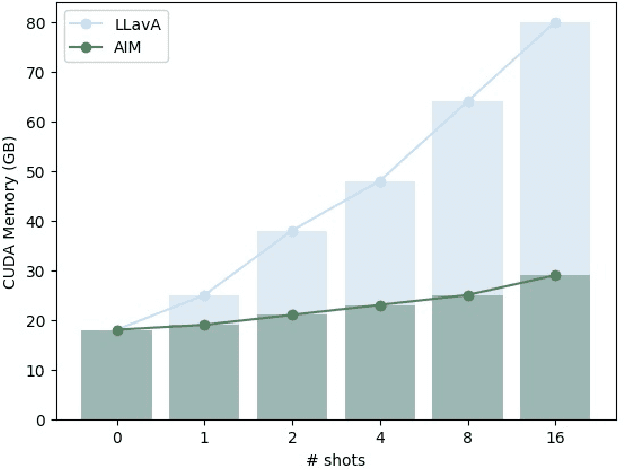

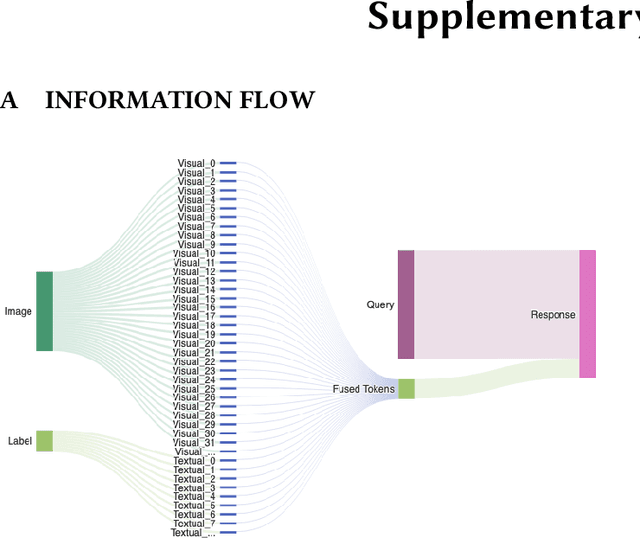
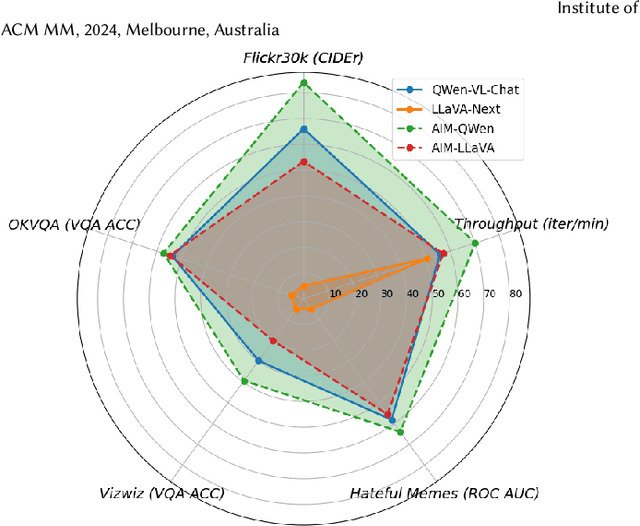
Abstract:In-context learning (ICL) facilitates Large Language Models (LLMs) exhibiting emergent ability on downstream tasks without updating billions of parameters. However, in the area of multi-modal Large Language Models (MLLMs), two problems hinder the application of multi-modal ICL: (1) Most primary MLLMs are only trained on single-image datasets, making them unable to read multi-modal demonstrations. (2) With the demonstrations increasing, thousands of visual tokens highly challenge hardware and degrade ICL performance. During preliminary explorations, we discovered that the inner LLM tends to focus more on the linguistic modality within multi-modal demonstrations to generate responses. Therefore, we propose a general and light-weighted framework \textbf{AIM} to tackle the mentioned problems through \textbf{A}ggregating \textbf{I}mage information of \textbf{M}ultimodal demonstrations to the dense latent space of the corresponding linguistic part. Specifically, AIM first uses the frozen backbone MLLM to read each image-text demonstration and extracts the vector representations on top of the text. These vectors naturally fuse the information of the image-text pair, and AIM transforms them into fused virtual tokens acceptable for the inner LLM via a trainable projection layer. Ultimately, these fused tokens function as variants of multi-modal demonstrations, fed into the MLLM to direct its response to the current query as usual. Because these fused tokens stem from the textual component of the image-text pair, a multi-modal demonstration is nearly reduced to a pure textual demonstration, thus seamlessly applying to any MLLMs. With its de facto MLLM frozen, AIM is parameter-efficient and we train it on public multi-modal web corpora which have nothing to do with downstream test tasks.
TALDS-Net: Task-Aware Adaptive Local Descriptors Selection for Few-shot Image Classification
Dec 09, 2023Abstract:Few-shot image classification aims to classify images from unseen novel classes with few samples. Recent works demonstrate that deep local descriptors exhibit enhanced representational capabilities compared to image-level features. However, most existing methods solely rely on either employing all local descriptors or directly utilizing partial descriptors, potentially resulting in the loss of crucial information. Moreover, these methods primarily emphasize the selection of query descriptors while overlooking support descriptors. In this paper, we propose a novel Task-Aware Adaptive Local Descriptors Selection Network (TALDS-Net), which exhibits the capacity for adaptive selection of task-aware support descriptors and query descriptors. Specifically, we compare the similarity of each local support descriptor with other local support descriptors to obtain the optimal support descriptor subset and then compare the query descriptors with the optimal support subset to obtain discriminative query descriptors. Extensive experiments demonstrate that our TALDS-Net outperforms state-of-the-art methods on both general and fine-grained datasets.
 Add to Chrome
Add to Chrome Add to Firefox
Add to Firefox Add to Edge
Add to Edge